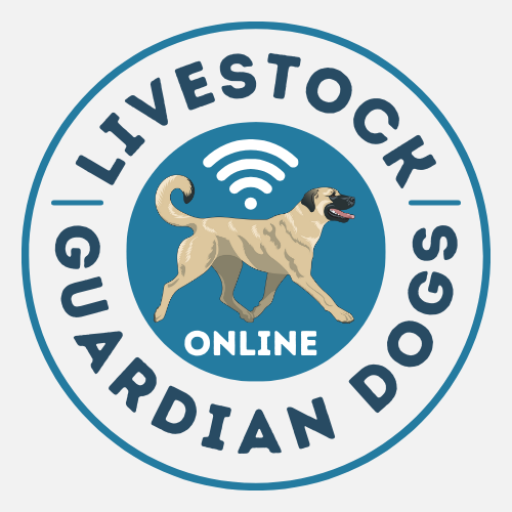Livestock Guardian Dogs Predators
June 10th, 2019
Born to be Wild: Solutions
Please read the first post, Born to be Wild: Predator where I gave my take on an adult LGD and her puppies being killed by wolves. Today, let’s look at preventative measures that producers can use to mitigate our losses and set our animals up for success.
I mentioned the two primary characteristics that govern a wolf’s behavior: Opportunistic and Territorial. Taking these two factors into account, the goal of anyone running stock in a predator heavy environment should be to minimize the opportunity and maximize the territory hold of their property to dissuade predators.
Solutions vary by situation.
Some ranchers are successful with fladry or electric fencing to dissuade predators from their property. In the link, you’ll see that fladry is more of a temporary measure, and that wolves no longer respect the random flapping motion as a threat to them after a few exposures. Thus, it is most useful during lambing/calving season. Electric fencing is highly effective when it is hot, especially with bears. My issue with electric fencing has always been weeds grounding out the bottom line or goats chewing the wire or tape (I know, I don’t get it either). We use regular, woven wire field fence with a barbed wire topper. Inside the fence with our animals are livestock guardian dogs, 24/7/365.
Why LGDs?
Unlike fladry, electric fences and firearms, livestock guardian dogs speak in a language all predators understand:
Verbal: Perimeter, alert, and communicative barking/howling.
Scent: Marking territory with urine and feces.
This means that when a wolf, bear, cougar, coyote, raccoon, etc. comes upon my property line, they know something formidable lies beyond. While all my dogs are around 100-130 lb mature, they don’t need to outweigh the predators to be effective (common misconception). The mere presence of large, defensive dogs all but eliminates the opportunity in your livestock. The instinctual risk/reward analysis that all wild predators have will tell them “I might get hurt or killed before I get that meal.” That internal warning is all it takes for a healthy predator to move on, which is our goal. Physical confrontation is not the goal of any responsible LGD handler. While it makes a great bar (or Facebook) story, your dog limping home after being torn up by a predator isn’t good. Imagining that he “won” doesn’t make it any less problematic.

When we look at physical conflict between LGDs and predators, usually one or more of the following factors is involved:
1. Predator is desperate – injured, ill, or starving.
2. Predator is a female with babies – more aggressive and behave differently than they would on their own.
3. Dog is alone – A single dog is no match for most apex predators in the US or Canada. This includes a single wolf or a small group of coyotes. (Do not email me to tell me how special and amazing your single dog is because s/he fought off a _____ alone. All that means is that you aren’t setting your dog up for safety and success.)
4. Dog is immature – Asking a 1 year old pup to safely stand down a predator is irresponsible. If you don’t have any mature LGDs, you and your firearm are the working partner of your dog.
5. Dog is not an LGD – Some people put their pet dogs out with their goats because “He’s so good with them! He’ll protect them.” Unless the largest predator is a raccoon, this usually doesn’t work. Not only because the dog doesn’t have the temperament, defense drive or bond to perform the job – but because they themselves are likely a threat to the stock when unattended.
6. Dog or Wolf is in heat – Hormones can betray instincts and lead to confused LGDs and predators alike. An LGD bitch in heat can attract wild and domestic canines from miles away.
So what has worked for us for the last 9 years in wolf, black and brown bear, cougar, etc. country?
Fence: 47″ high woven wire field fence from RedBrand. Steel, not aluminum. 1-2 Barbed wire toppers spaced 3 inches from the fence/each other. SportDOG 100A invisible fence wire zip tied TO THE FIELD FENCE (never alone), and collars on all adult dogs.
Dogs: Plural! More than one. We currently (May 2019) have 3 adults, 1 adolescent and a new pup coming in. Our happy number is 5-6 adults. This makes it so we can run a pair/trio setup in Summer and Winter, regardless of heats/whelping. The pack and livestock all run together in the Spring and Fall for the increased pressure from bears.
Pasture clearing: We own a forest at the bottom of a mountain. Not only does thick tree growth prevent grass from growing, but it also obstructs the view of humans, dogs, and stock. The trees provide predators with cover and escape (lions and bears). So part of our ongoing to-do list is thinning the trees, adding top soil and perennial grass seed, and clearing the underbrush.
Thermal Scope: We tried night vision. It was incredibly ineffective save for the open field. Trees blocking line of sight left us blind. We returned it and got a thermal scope instead. Heat signatures are much easier to find and you can see residual paw prints and sign at night if they are warmer than the ambient air temperature. This helps when the dogs are alerting but we can’t see what they see/smell. We don’t sweat the small stuff like raccoons and opossums. But if the dogs are upset, we usually find prints of a running large predator that just passed through. It’s nice to know that the barking works faster than we can get boots on 99% of the time.
What has worked for you to prevent predator conflict and loss? Comment below!

